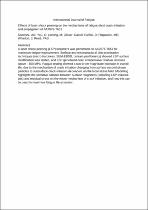 ResearchSpace
ResearchSpace
Effects of laser shock peening on the mechanisms of fatigue short crack initiation and propagation of AA7075-T651
JavaScript is disabled for your browser. Some features of this site may not work without it.
- ResearchSpace
- →
- Research Publications/Outputs
- →
- Conference Publications
- →
- View Item
| dc.contributor.author |
Sanchez, AG

|
|
| dc.contributor.author |
You, C

|
|
| dc.contributor.author |
Leering, M

|
|
| dc.contributor.author |
Glaser, Daniel

|
|
| dc.contributor.author |
Furfari, D

|
|
| dc.contributor.author |
Fitzpatrick, ME

|
|
| dc.contributor.author |
Wharton, J

|
|
| dc.contributor.author |
Reed, PAS

|
|
| dc.date.accessioned | 2021-05-25T17:15:49Z | |
| dc.date.available | 2021-05-25T17:15:49Z | |
| dc.date.issued | 2020-11 | |
| dc.identifier.citation | Sanchez, A., You, C., Leering, M., Glaser, D., Furfari, D., Fitzpatrick, M., Wharton, J. & Reed, P. et al. 2020. Effects of laser shock peening on the mechanisms of fatigue short crack initiation and propagation of AA7075-T651. <i>International Journal of Fatigue, 143.</i> http://hdl.handle.net/10204/12019 | en_ZA |
| dc.identifier.issn | 0142-1123 | |
| dc.identifier.issn | 1879-3452 | |
| dc.identifier.uri | https://doi.org/10.1016/j.ijfatigue.2020.106025 | |
| dc.identifier.uri | http://hdl.handle.net/10204/12019 | |
| dc.description.abstract | A laser shock peening (LSP) treatment was performed on AA7075-T651 for maximum fatigue improvement. Surface and microstructural characterisation techniques (micro-hardness, SEM-EBSD, contact-profilometry) showed LSP surface modification was limited, and LSP generated deep compressive residual stresses above - 300 MPa. Fatigue testing showed a two-order magnitude increase in overall life, due to the mechanism of crack initiation changing from surface second-phase particles to subsurface crack initiation dependent on the local stress field. Modelling highlights the sensitive balance between surface roughness (including LSP-induced pits) and residual stress on the micro-mechanism of crack initiation, and how this can be used to maximise fatigue life extension. | en_US |
| dc.format | Abstract | en_US |
| dc.language.iso | en | en_US |
| dc.relation.uri | https://www.sciencedirect.com/science/article/pii/S0142112320305570 | en_US |
| dc.source | International Journal of Fatigue, 143 | en_US |
| dc.subject | Aluminium alloys | en_US |
| dc.subject | Fatigue initiation | en_US |
| dc.subject | Micromechanics | en_US |
| dc.subject | Surface flaws | en_US |
| dc.title | Effects of laser shock peening on the mechanisms of fatigue short crack initiation and propagation of AA7075-T651 | en_US |
| dc.type | Article | en_US |
| dc.description.pages | 14 | en_US |
| dc.description.note | © 2020 Elsevier Ltd. All rights reserved. Due to copyright restrictions, the attached PDF file only contains the abstract of the full text item. For access to the full text item, kindly consult the publisher's website: https://www.sciencedirect.com/science/article/pii/S0142112320305570 | en_US |
| dc.description.cluster | Manufacturing | en_US |
| dc.description.impactarea | Laser Enabled Manufacturing | en_US |
| dc.identifier.apacitation | Sanchez, A., You, C., Leering, M., Glaser, D., Furfari, D., Fitzpatrick, M., ... Reed, P. (2020). Effects of laser shock peening on the mechanisms of fatigue short crack initiation and propagation of AA7075-T651. <i>International Journal of Fatigue, 143</i>, http://hdl.handle.net/10204/12019 | en_ZA |
| dc.identifier.chicagocitation | Sanchez, AG, C You, M Leering, Daniel Glaser, D Furfari, ME Fitzpatrick, J Wharton, and PAS Reed "Effects of laser shock peening on the mechanisms of fatigue short crack initiation and propagation of AA7075-T651." <i>International Journal of Fatigue, 143</i> (2020) http://hdl.handle.net/10204/12019 | en_ZA |
| dc.identifier.vancouvercitation | Sanchez A, You C, Leering M, Glaser D, Furfari D, Fitzpatrick M, et al. Effects of laser shock peening on the mechanisms of fatigue short crack initiation and propagation of AA7075-T651. International Journal of Fatigue, 143. 2020; http://hdl.handle.net/10204/12019. | en_ZA |
| dc.identifier.ris | TY - Article AU - Sanchez, AG AU - You, C AU - Leering, M AU - Glaser, Daniel AU - Furfari, D AU - Fitzpatrick, ME AU - Wharton, J AU - Reed, PAS AB - A laser shock peening (LSP) treatment was performed on AA7075-T651 for maximum fatigue improvement. Surface and microstructural characterisation techniques (micro-hardness, SEM-EBSD, contact-profilometry) showed LSP surface modification was limited, and LSP generated deep compressive residual stresses above - 300 MPa. Fatigue testing showed a two-order magnitude increase in overall life, due to the mechanism of crack initiation changing from surface second-phase particles to subsurface crack initiation dependent on the local stress field. Modelling highlights the sensitive balance between surface roughness (including LSP-induced pits) and residual stress on the micro-mechanism of crack initiation, and how this can be used to maximise fatigue life extension. DA - 2020-11 DB - ResearchSpace DP - CSIR J1 - International Journal of Fatigue, 143 KW - Aluminium alloys KW - Fatigue initiation KW - Micromechanics KW - Surface flaws LK - https://researchspace.csir.co.za PY - 2020 SM - 0142-1123 SM - 1879-3452 T1 - Effects of laser shock peening on the mechanisms of fatigue short crack initiation and propagation of AA7075-T651 TI - Effects of laser shock peening on the mechanisms of fatigue short crack initiation and propagation of AA7075-T651 UR - http://hdl.handle.net/10204/12019 ER - | en_ZA |
| dc.identifier.worklist | 24462 | en_US |





